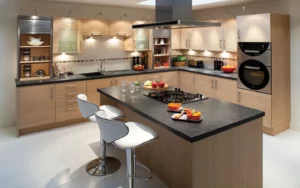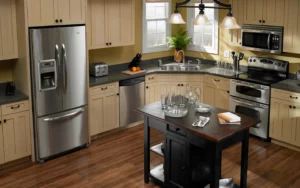Kitchen design is crucial for more than just its functionality. It can elevate the overall experience of cooking, dining, and gathering, making it an essential aspect of any home. A well-designed kitchen maximizes efficiency and workflow, saving time and enhancing productivity. It prioritizes comfort and safety through ergonomic considerations and creates a welcoming environment.
Kitchen Design Importance
Kitchens have evolved into social hubs where families and friends gather, fostering connection and creating lasting memories. A thoughtfully designed kitchen provides:
- Ample space for entertaining guests.
- Accommodating conversations.
- Integrating with other living areas.
The visual appeal of a kitchen is also significant. Stylish cabinetry, attractive countertops, and well-chosen finishes contribute to the overall ambiance, adding value to the home and attracting potential buyers.

Moreover, kitchen design allows for personal expression, reflecting individual style preferences. From colors and materials to personalized touches, homeowners can create a kitchen that aligns with their unique taste and personality. Investing in a well-designed kitchen transforms it into a space that nurtures culinary pursuits, fosters connection, and becomes the heart of the home. In summary, kitchen design is crucial for its functionality, comfort, social atmosphere, aesthetic appeal, and personal expression it brings to a home.
The design of kitchen cabinets plays a crucial role in creating a functional and aesthetically pleasing space. Here are some key principles to consider when designing kitchen cabinets:
Functionality
The primary purpose of kitchen cabinets is to provide storage and organization. Design cabinets that optimize storage space and make it easy to access items efficiently. Consider the needs of the user and design cabinets that accommodate various kitchen tools, utensils, cookware, and pantry items.
Layout and Flow
The layout of kitchen cabinets should promote a smooth workflow. Arrange cabinets strategically to create efficient work zones, such as grouping cooking-related items near the stove and placing frequently used items within easy reach. Consider the triangle principle, which involves positioning the sink, stove, and refrigerator close for convenience.
Aesthetics
Cabinets contribute significantly to the overall look and style of the kitchen. Choose a design that complements the overall theme, whether modern, traditional, rustic, or contemporary. Select appropriate materials, finishes, colors, and hardware that harmonize with the kitchen’s design aesthetic.

Explore more Open kitchen entrance design
Quality and Durability
Invest in high-quality cabinets built to last. Choose durable materials, such as solid wood or high-quality plywood, and consider features like solid construction, sturdy hinges, and smooth drawer glides. Well-built cabinets withstand daily use and add value to your kitchen.
Proper Lighting
Incorporate lighting elements into cabinet design to enhance functionality and ambiance. Install under-cabinet lighting to illuminate countertops and workspace, making tasks easier. Consider internal cabinet lighting or glass-front cabinets to showcase decorative items.
Ergonomics
Pay attention to the ergonomics of cabinet design to ensure ease of use. Consider the height and depth of cabinets, placing frequently used items at accessible heights. Incorporate features like pull-out shelves, lazy Susans, and adjustable dividers to maximize storage and improve accessibility.
Balance and Proportion
Achieve visual harmony by maintaining balance and proportion in cabinet design. Avoid overcrowding or leaving empty gaps. Balance the sizes and placement of cabinets and ensure they harmonize with the kitchen design.
Integration with Appliances
Consider integrating kitchen appliances, such as refrigerators, ovens, and dishwashers, within cabinet design. Design cabinets that seamlessly incorporate these appliances, creating a cohesive and streamlined look.

Personalization
Customization allows you to tailor cabinets to your needs and preferences. Consider personalizing cabinet features, such as specialized storage solutions, pull-out trash bins, or built-in charging stations, to enhance convenience and organization.
Sustainability
Design cabinets with sustainability in mind. Choose eco-friendly materials, such as responsibly sourced wood or recycled materials, and opt for low VOC finishes. Consider long-term durability and energy-efficient features to minimize environmental impact.
By following these principles, you can create kitchen cabinets that are beautiful and stylish, highly functional, organized, and tailored to your needs.
Read more about: Renovating cabinets
Kitchen Design Principles
In the realm of kitchen design, there exist three fundamental principles that designers often adhere to, whether by intention or innate understanding:

- kitchen work zones
- the work triangle
- visual balance
By embracing these principles, designers strive to craft kitchens that harmonize functionality, aesthetics, and client satisfaction. These kitchens are visually appealing and simplify and streamline their tasks.
It is important to note that these principles should be considered as flexible building regulations. Instead, they serve as guiding principles facilitating the design process, allowing designers to create truly shining spaces.
KEYWORDS:
